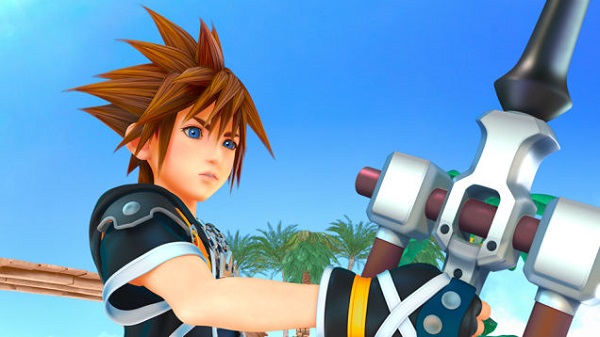The Kingdom Hearts Series
Square Enix
Square Enix, h.a.n.d., Jupiter, Disney Interactive Studios
PS2, Game Boy Advance, Nintendo DS, PSP, Nintendo 3DS, PS3 (coming soon to PS4 and XboxOne)
Final Fantasy and Disney together in one universe. Logically, it sounds like a terrible idea. Yet Kingdom Hearts, an action role-playing game, has managed to harmoniously bring these two extremely different universes together, reaffirming the old saying “opposites attract.” In fact, Kingdom Hearts is six games strong, with a seventh in the works, has won several awards, and is one of the most successful video game franchises of all time.
The magic behind the Kingdom Hearts series lies in the cast of original characters, Square Enix’s use of Final Fantasy and Disney, and game design.
At the beginning of the series, players are introduced to the two main protagonists: Sora, a cheerful fourteen-year-old boy who accidentally becomes the hero, and his best friend, Riku, the chosen Keyblade wielder who struggles with the darkness within him. Players are drawn to Sora because of his upbeat attitude and unwavering commitment to his friends, while Riku holds our interest because he makes a mistake and has spent the better part of the series trying to set things right.
While some fans desire to see more characters from Final Fantasy cross over to even out the strong Disney presence, Square Enix made the right move in creating new characters from the ground up rather than relying on their existing franchise. Adding a mixture of fresh characters allows the story to follow a Final Fantasy formula while protecting Disney characters from the brooding nature of Final Fantasy characters.
Another crucial aspect of Kingdom Hearts is that no one from the Final Fantasy is Disney-fied, nor is anyone from Disney converted to anime. What unites the two universes are solid world designs that feel unified. Each world has its own unique design; however, all of the worlds could exist on one planet. Characters fit in any world they visit even though they don’t belong. Of course, this makes sense in the grand scheme of things because players learn that long ago all the worlds were connected.
Since the first games release in 2002, players have walked in the shoes of five characters, traveled through 39 worlds, wielded approximately 98 different Keyblades, and fought thousands of Heartless. As director Testsuya Nomura and his team begin working on Kingdom Hearts III, here’s a brief look back at the series so far.
Kingdom Hearts kicks off with Sora, Donald, and Goofy fighting off the Heartless and restoring light to the universe by ultimately defeating Ansem, the main antagonist. To the surprise of many, Kingdom Hearts is not a turn base battle system. Players are free to swing away at any Heartless in their path. Summons are all Disney characters.
Kingdom Hearts: Chain of Memories serves as a bridge between Kingdom Hearts and Kingdom Hearts II. In the game, Sora travels to from the ground level to the top of Castle Oblivion. Each level Sora advances, cause him to lose part of his memory. At the same time, Riku is fighting his way up from the basement of the Castle to the ground level with the help of King Mickey. This is perhaps the least popular game in the series due to its card based battle system.
Kingdom Hearts II begins where Chain of Memories left off, with Sora sound asleep, waiting to merge with his Nobody Roxas. Once awakened, Sora and the gang must repair damaged worlds and protect Kingdom Hearts from The Organization. Drive Forms were added to the battle system which led to dual wielding, and a whole lot of awesome.
Kingdom Hearts: 358/2 Days, an interquel for the series, began at the end of Kingdom Hearts, ran parallel to Chain of Memories, and ended before Kingdom Hearts II. The story is told through Roxas’ perspective during his time with The Organization, and his relationship with fellow members Axel and Xion.
Kingdom Hearts: Birth By Sleep serves as a prequel to the series. Taking a step back in time, we learn more about Keyblade wielders and the Door of Light. Players are introduced to three new playable characters: Ventus, Aqua, and Terra, who each have their own unique skill set.
Although the battle system remains the same, players were delighted to find that they could customize their Command Deck, and Meld attacks together to create something entirely new. The possibilities seemed endless.
Kingdom Hearts: Dream, Drop, Distance moves the story forward, holding over eager fans until Kingdom Hearts III is completed. In this game, we see Riku and Sora take the Mark of Mastery Exam in order to become full-fledged Keyblade Masters. During the exam, Ansem appears and the trouble begins.
Instead of Disney summons players team up with Dream Eaters. A new feature to the game is Flowmotion which allows players to move quickly about by performing actions such as bouncing off walls, grinding on rails and spinning around poles.
Kingdom Hearts III will follow Sora’s search for the “Key to Return Hearts” while Riku and King Mickey search for Keyblade wielders. According to director Testsuya Nomura, this game will conclude the “Dark Seeker Saga,” but will not be the final game in the series.









